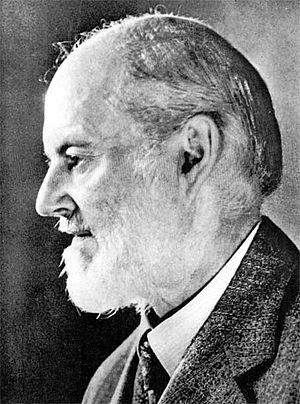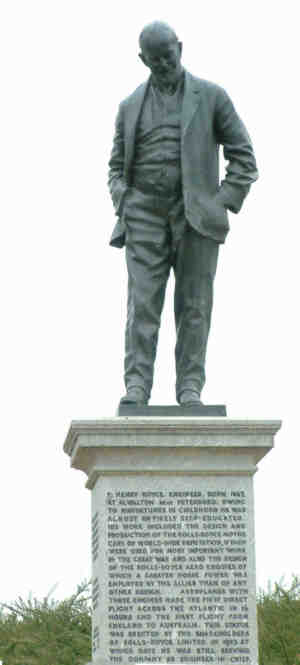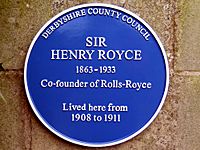Henry Royce facts for kids
Quick facts for kids
Henry Royce
|
|
|---|---|
 |
|
| Born |
Frederick Henry Royce
27 March 1863 Alwalton, Huntingdonshire, England
|
| Died | 22 April 1933 (aged 70) West Wittering, Sussex, England
|
| Occupation | Engineer |
| Spouse(s) |
Minnie Punt
(m. 1893–1912) |
| Engineering career | |
| Projects | Rolls-Royce |
Sir Frederick Henry Royce (born March 27, 1863 – died April 22, 1933) was a brilliant English engineer. He was known for designing very reliable and long-lasting car and airplane engines. He co-founded the famous company Rolls-Royce with Charles Rolls and Claude Johnson.
At first, Rolls-Royce made big, powerful cars like the Silver Ghost. When World War I started, Royce designed his first airplane engine. Soon, making airplane engines became the most important part of Rolls-Royce's business.
Royce's health became poor in 1911. He was convinced to leave his factory in Derby and move south, taking some designers with him. He spent winters in the south of France. He passed away at his home in Sussex in 1933.
Contents
Early Life and First Businesses
Henry Royce was born in Alwalton, Huntingdonshire, England, in 1863. He was the youngest of five children. His father ran a flour mill, but the business failed, and his family moved to London. When his father died in 1872, Henry had to start working at a young age. He sold newspapers and delivered telegrams after only one year of school.
In 1878, with financial help from an aunt, he began an apprenticeship at the Great Northern Railway company in Peterborough. After three years, he ran out of money. He then worked briefly for a tool-making company in Leeds before returning to London. He joined the Electric Light and Power Company and later moved to their Liverpool office, working on street and theater lighting.
In 1884, Royce started his own business with a friend, Ernest Claremont. They used Royce's £20 savings and Claremont's £50. Their company, F. H. Royce and Company, made electric fittings for homes in Manchester. By 1894, they began making dynamos (machines that make electricity) and electric cranes. The company became Royce Ltd in 1899 and opened another factory.
Partnership with Charles Rolls

After a business slowdown and more competition from other countries, Royce started thinking about making cars. He loved mechanical things and became very interested in cars. He bought a small car in 1901 and then a 1901 Decauville car. He wasn't happy with its quality, so he improved it. Then, in 1904, he decided to build his own car in his workshop.
He built two more cars. One was given to his business partner, Ernest Claremont, and the other was sold to a director named Henry Edmunds. Edmunds was a friend of Charles Rolls, who owned a car showroom in London. Edmunds showed Rolls his Royce car and arranged a meeting between Rolls and Royce. This famous meeting happened on May 4, 1904, at the Midland Hotel in Manchester.
Rolls was impressed with Royce's two-cylinder car, even though he usually preferred cars with more cylinders. On December 23, 1904, they made an agreement. Rolls would buy all the cars Royce could make. These cars would have two, three, four, or six cylinders and would be called Rolls-Royce.
The first Rolls-Royce car, the Rolls-Royce 10 hp, was shown at the Paris Salon in December 1904. In 1906, Rolls and Royce officially formed Rolls-Royce Limited. Royce became the chief engineer and works director. He brought the technical skills, while Rolls provided financial support and business knowledge. By 1907, their cars were winning awards for their reliable engineering.
The Rolls-Royce Eagle was the first airplane engine developed by Rolls-Royce Limited. It was created in 1915 during World War I to meet British military needs. It became one of the most successful airplane engines used by the Allies during the war.
Royce & Company, which made cranes, continued as a separate business until 1932. The last crane designed by Royce was built in 1964. The partnership between Rolls and Royce ended when Charles Rolls died in 1910 in an airplane crash.
Developing Rolls-Royce Engines
Royce was known for working very hard and often skipping meals. This led to him becoming ill in 1902 and again in 1911. His poor health forced him to move away from Derby in 1912. That same year, he had a major operation and doctors thought he only had a few months to live. Despite this, he returned to work.
He could no longer visit the factory, which had moved to larger premises in Derby in 1908. However, he insisted on checking all new designs himself. Engineers and designers had to bring their drawings to him for his personal approval. This was a challenging task because he was known for his perfectionism. He had a villa built in Le Canadel in the south of France and another home in Crowborough, East Sussex. In 1917, Royce moved to West Wittering, West Sussex.
In October 1928, Royce began designing the "R" engine. He was walking on the beach at West Wittering with his engineers, sketching ideas in the sand. Less than a year later, the "R" engine, designed in his studio, set a new world air speed record of 357.7 miles per hour. It also helped win the Schneider Trophy in 1929.
When the government decided not to fund the next attempt in 1931, a woman named Lucy, Lady Houston stepped in. She felt Britain must compete and offered £100,000 to cover the costs. This made the government change its mind. Royce then found a way to make the "R" engine even more powerful. The Supermarine S.6B seaplane won the Trophy at 340.08 miles per hour on September 13, 1931. Later that month, on September 29, the same aircraft with an improved engine flew at 407.5 miles per hour. It became the first aircraft to fly over 400 miles per hour and broke the world speed record.
Bentley and the Merlin Engine
In 1931, Rolls-Royce Ltd. bought their rival company, W. O. Bentley. They put a "20/25" engine into a car chassis and added a Bentley radiator. An open four-seater body completed the car. The engine was made more powerful, and the car was taken to West Wittering for Royce's approval. Everyone was nervous about what he would say, but he approved it. He also suggested that such a fast car should have a way to change how stiff its suspension was.
The night before he died, Royce drew a sketch on the back of an envelope. He gave it to his nurse, Miss Aubin, telling her to make sure the "boys" at the factory received it safely. He died before it reached Derby. This sketch was for an adjustable shock-absorber. So, in 1933, the first Bentley made by Rolls-Royce Ltd appeared, carrying on another famous name.
After the success of the "R" engine, it was clear that they had an engine that would be useful for the Royal Air Force. Even though the government didn't offer help at first, Rolls-Royce went ahead and developed what they called the "PV-12" engine. This engine was designed to perform like the "R" engine but last much longer. Rolls-Royce launched the PV-12 in October 1933, and the engine completed its first test in 1934, the year after Royce died. The PV-12 later became the famous Rolls-Royce Merlin engine.
Personal Life and Legacy
Henry Royce married Minnie Punt in 1893. They lived in Chorlton-cum-Hardy, Manchester, with his mother and Minnie's niece, Violet. In 1898, the Royces moved to a new house in Knutsford, Cheshire. Henry and Minnie separated in 1912.
Royce lived by the motto: "Whatever is rightly done, however humble, is noble." He was awarded the OBE in 1918. In 1930, he was made a baronet (a special title of honor) for his important contributions to British aviation. He had no children, so his baronetcy ended when he died.
After he became ill, Royce was cared for by a nurse, Miss Ethel Aubin, for twenty years. He died at his house in West Wittering on April 22, 1933. His ashes were first buried under his statue at the Rolls-Royce factory in Derby. However, in 1937, his urn was moved to the church in Alwalton, where he was born.
In 1962, a special memorial window dedicated to Henry Royce was unveiled in Westminster Abbey. He is also remembered at Royce Hall, student housing at Loughborough University. The Sir Henry Royce Suite, a business area, is named after him at the Peterborough Marriott Hotel.
Cultural Depictions
Actor Michael Jayston played Henry Royce in the 1972-1973 BBC Television miniseries The Edwardians.
Bibliography
- Bird, Anthony; Hallows, Ian (1984). The Rolls-Royce Motor Car and the Bentley since 1931 (5 ed.). New York: St. Martin’s Press. ISBN 0-312-68957-8. (1st edition 1964)
See also
 In Spanish: Henry Royce para niños
In Spanish: Henry Royce para niños



